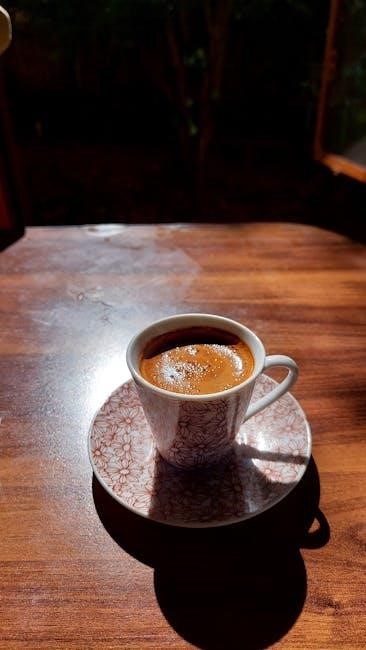
espresso guide
Espresso, at its heart, is a concentrated coffee beverage brewed by forcing hot water through finely-ground coffee beans. This guide will explore everything from basics to advanced techniques, helping you to master the art of espresso.
What is Espresso?
Espresso isn’t just a type of coffee bean or a specific roast; it’s a method of brewing. It involves forcing hot water, typically at pressures between 6 and 9 BAR, through a bed of finely ground coffee. The result is a small, concentrated shot of coffee with a rich flavor and creamy texture.
Traditionally, a single shot of espresso is quite small, but there’s no universally agreed-upon size. It’s the foundation for many popular coffee drinks, offering a unique balance of intensity and flavor. Mastering espresso unlocks a world of coffee possibilities, from lattes to cappuccinos. Remember, the fundamentals are essential for achieving the perfect brew.
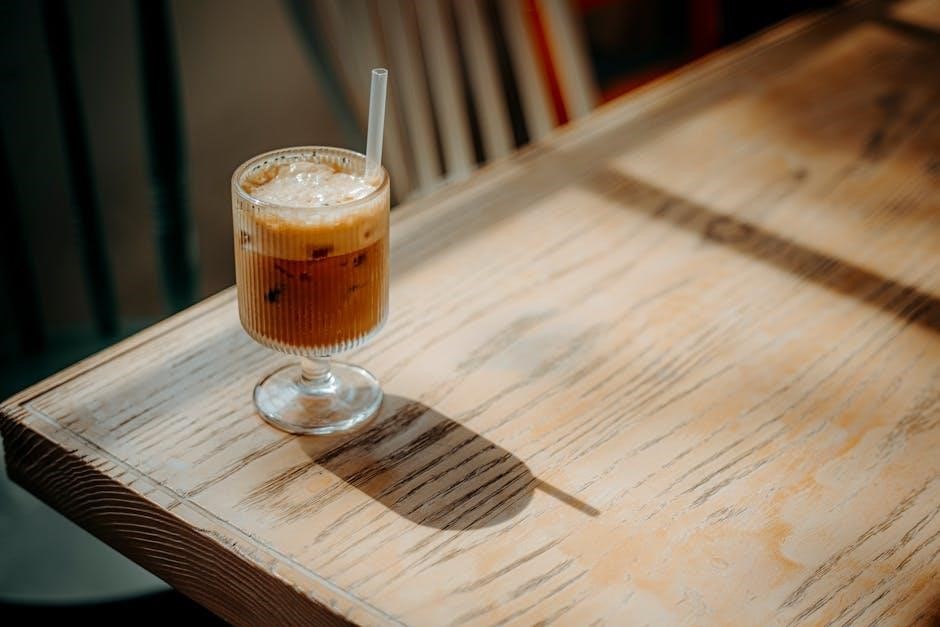
Espresso Basics
Understanding the fundamentals is crucial for crafting exceptional espresso. We’ll delve into the core principles that define espresso, setting a foundation for mastering brewing techniques and exploring its diverse applications.
Espresso Definition
Espresso is a concentrated coffee beverage brewed by forcing pressurized hot water through finely-ground coffee beans. Typically, this pressure ranges from 6 to 9 BAR. This extraction method differentiates espresso from other coffee preparations. It’s not a specific bean or roast, but a brewing process that yields a small, intense shot of coffee. A single shot is traditionally around 1 ounce. The result is a drink characterized by its rich flavor, crema (a layer of foamy emulsion), and caffeinated kick. Espresso forms the base for many popular coffee drinks, showcasing its versatility. Mastering the art of espresso requires understanding the key variables involved in its preparation.
Espresso vs. Other Coffee Drinks
Espresso differs significantly from other coffee drinks in its concentration and brewing method. Unlike drip coffee, which is brewed by gravity, espresso uses pressure to extract flavor. This results in a smaller, more intense beverage. Compared to French press, espresso offers a cleaner taste due to its filtration process. Cold brew, steeped for hours, contrasts with espresso’s rapid extraction. The key distinctions lie in the coffee-to-water ratio, brewing time, and pressure applied. These factors create unique flavor profiles and textures. Espresso’s concentrated nature makes it ideal as a base for lattes, cappuccinos, and other milk-based drinks, offering a versatile coffee experience.

Essential Equipment for Espresso
To craft exceptional espresso, specialized equipment is essential. This includes a quality espresso machine, a precise grinder, a portafilter, and tamping tools. Each component plays a critical role in the brewing process.
Espresso Machine Components
An espresso machine is composed of several key elements, each contributing to the final brew. The group head is where the portafilter locks in, ensuring a tight seal for pressure. Essential components include the portafilter, group head, steam wand, and boiler, each playing a role in brewing. The boiler heats the water to the optimal temperature. The steam wand froths milk for lattes and cappuccinos.
Understanding the function of each part is crucial for consistent espresso. Pressure gauges monitor the extraction process. Water reservoirs or direct water lines supply the machine. Proper maintenance and cleaning of these components will significantly extend the life of the machine and maintain optimal performance.
Grinder Selection
Selecting the right grinder is paramount for quality espresso. Burr grinders are preferred over blade grinders due to their consistent grind size, which is crucial for even extraction. Conical burr grinders operate at lower speeds, minimizing heat transfer and preserving coffee aroma. Flat burr grinders offer high speed and efficiency.
Consider the grinder’s adjustability to fine-tune grind size for different beans and desired tastes. Look for a grinder with stepless adjustment for precise control. The grinder’s capacity and speed should align with your daily espresso needs. Investing in a quality grinder will significantly improve your espresso experience.
Portafilter and Baskets
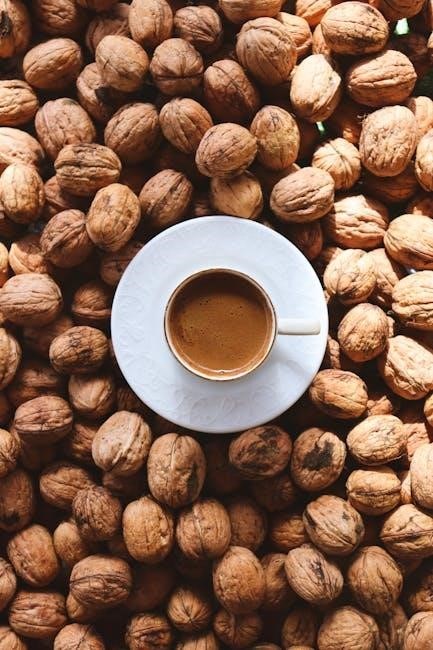
The portafilter is the handle that holds the coffee basket, where ground coffee is tamped before brewing. Portafilters come in various sizes, typically 58mm, which is considered the professional standard, and 53mm. The basket within the portafilter holds the ground coffee.
Baskets can be single, double, or triple, corresponding to the dose of coffee they hold. Precision baskets are designed with consistent hole patterns for even extraction. A well-maintained portafilter and basket are essential for creating consistent and high-quality espresso shots. Regular cleaning is important to prevent residue buildup that can affect the taste.
Tamping Tools
Tamping tools, also known as tampers, are essential for compressing the coffee grounds evenly within the portafilter basket. This process creates a uniform density, ensuring the water flows through the coffee at an even rate during extraction. A good tamper should feel comfortable in your hand and have a flat, level base that matches the diameter of your portafilter basket.
There are various types of tampers, including calibrated tampers that provide consistent pressure, and distribution tools that help evenly distribute the grounds before tamping. Using the correct tamping technique and tool is crucial for achieving optimal espresso extraction and flavor. Uneven tamping can lead to channeling and inconsistent shots.
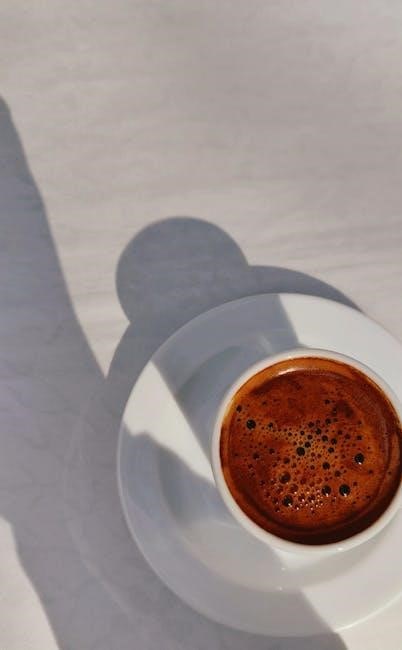
Espresso Brewing Process
The espresso brewing process involves several key steps, each contributing to the final taste and quality of the shot. These include grind size, tamping, brew ratio, temperature, and extraction time.
Grind Size and Dose
Grind size is crucial for proper espresso extraction. The grind needs to be fine, almost like powder, allowing the hot water to extract flavors effectively. Too coarse, and the water flows too quickly, resulting in a weak, sour espresso (under-extraction). Too fine, and the water struggles to pass through, leading to a bitter, over-extracted shot.
Dose refers to the amount of ground coffee used. The ideal dose varies depending on the basket size and the desired strength of the espresso. A standard double shot usually uses around 18-21 grams of coffee. Consistent dosing is essential for repeatable results. Adjusting both grind size and dose are key to dialing in your espresso, ensuring a balanced and flavorful extraction every time.
Tamping Technique
Tamping is the process of compressing the ground coffee evenly in the portafilter to create a firm, level puck. This resistance is essential for the espresso machine to generate the necessary pressure for proper extraction. Inconsistent tamping leads to uneven extraction, resulting in a shot that’s either sour or bitter.
The ideal tamping pressure is around 30 pounds of force, but consistency is more important than the exact number. Ensure the tamp is level to distribute the water evenly. A slight polish after tamping can help create a smooth surface. Practice and consistency are key to mastering the tamping technique. A well-tamped puck ensures consistent and flavorful espresso shots every time.
Brew Ratio
Brew ratio is a fundamental concept in espresso making, representing the relationship between the mass of ground coffee used (dose) and the mass of the resulting espresso shot (yield). It’s expressed as a ratio, such as 1:2, meaning 1 gram of coffee yields 2 grams of espresso.
Understanding brew ratio allows for consistent and repeatable results. A ristretto (restricted) typically has a ratio of 1:1 to 1:1.5, producing a concentrated, intense flavor. A normale (normal) is around 1:2, offering a balanced profile. A lungo (long) is 1:3 or higher, resulting in a larger, more diluted shot. Experimenting with brew ratios allows you to fine-tune the taste and strength of your espresso.
Brew Temperature
Brew temperature is a critical factor influencing the flavor of espresso. It refers to the temperature of the water as it passes through the coffee grounds during extraction. Maintaining a consistent and appropriate brew temperature is essential for achieving optimal results and avoiding undesirable flavors.
Generally, the ideal brew temperature for espresso falls between 195°F and 205°F (90°C and 96°C). Lower temperatures can lead to under-extraction, resulting in sour or weak espresso. Higher temperatures, on the other hand, can cause over-extraction, leading to bitter or burnt flavors. Precise temperature control, often found in higher-end espresso machines, allows for fine-tuning the extraction process to suit different coffee beans and desired flavor profiles. Adjusting brew temperature can significantly impact the final taste of your espresso.
Extraction Time
Extraction time, measured in seconds, is the duration hot water is forced through the coffee grounds. This is a key variable in espresso brewing, directly impacting the beverage’s taste and quality. The ideal extraction time typically falls between 25 and 30 seconds, although this can vary based on grind size, dose, and coffee bean type.
A shorter extraction time (under-extraction) often results in sour or acidic flavors due to insufficient solubilization of the coffee’s desirable compounds. Conversely, a longer extraction time (over-extraction) can lead to bitter and astringent flavors as undesirable compounds are extracted. Observing the flow of espresso during extraction provides valuable visual cues. A steady, even flow indicates a proper extraction, while sputtering or inconsistent flow might suggest channeling or other issues needing adjustment. Mastering extraction time is crucial for achieving a balanced and flavorful espresso.

Dialing In Espresso
Dialing in espresso refers to the process of fine-tuning your brewing parameters to achieve the perfect shot. This involves adjusting grind size and brew ratio to extract the optimal flavor profile from your coffee.
Adjusting Grind Size
Grind size is a crucial element in espresso extraction. It dictates water flow resistance and influences the taste. Finer grinds offer more surface area, leading to slower extraction and potentially bitter flavors if over-extracted. Coarser grinds, however, allow water to flow through quickly, possibly resulting in weak, sour, or under-extracted shots.
The ideal grind size should provide balanced resistance, enabling a proper brew time and resulting in a sweet, rich, and complex espresso. Adjustments need to be incremental. If the shot is sour, grind finer. If it’s bitter, grind coarser. Consistency is key, so make small adjustments until you achieve the desired taste.
Remember that different beans and machines will require varying grind settings to produce the best espresso.
Adjusting Brew Ratio
Brew ratio, the relationship between the weight of ground coffee and the weight of the extracted espresso, is essential for dialing in the perfect shot. A tighter ratio (e.g., 1:1.5) produces a more concentrated, intense flavor, while a looser ratio (e.g., 1:3) results in a longer, more mellow beverage. Begin with a standard ratio (e.g., 1:2) and adjust based on taste.
If the espresso is too strong or bitter, increase the yield (loosen the ratio) by extracting more liquid while keeping the dose constant. Conversely, if the espresso is weak or sour, decrease the yield (tighten the ratio) by extracting less liquid. Small adjustments are crucial, as even slight changes can significantly impact the final taste.
Maintaining consistency in your dose and grind size is important when adjusting brew ratio to accurately evaluate the impact of ratio changes on the espresso’s flavor profile.
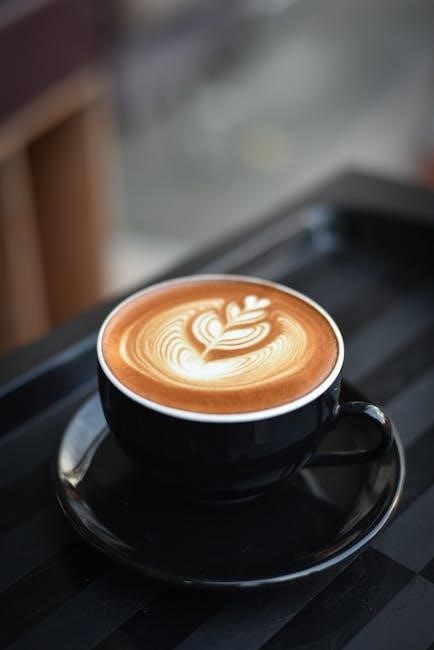
Espresso-Based Drinks
Espresso forms the foundation for various coffee beverages, each offering a unique balance of espresso intensity, milk texture, and sweetness. Mastering espresso opens the door to creating lattes, cappuccinos, macchiatos, and more.
Espresso Drinks
The world of espresso-based beverages is vast and varied, each offering a unique flavor profile and experience. A classic espresso shot, served neat, provides the purest coffee flavor. Adding hot water creates an Americano, a longer drink with a similar strength to brewed coffee.
For those who enjoy milk-based drinks, the options are plentiful. A cappuccino combines espresso with steamed milk and foamed milk, creating a balanced and textured beverage. A latte features espresso with steamed milk and a thin layer of foam, offering a smoother and creamier taste. A macchiato is marked by a dollop of foamed milk on top of espresso, providing a stronger coffee flavor with a touch of sweetness.
These are just a few examples of the many delicious espresso drinks you can create, each customizable to your preference.

Tips for Beginners
Embarking on your espresso journey can be exciting! Start with fresh, quality beans and a reliable grinder. Consistency is key, so practice your tamping and be patient while dialing in your grind size.
Espresso Tips

Mastering espresso takes time and dedication. Don’t be discouraged by initial failures; every shot is a learning opportunity.
Pay close attention to the aroma, color, and taste of your espresso to understand how adjustments impact the final result. A consistent grind is crucial; invest in a quality burr grinder.
Experiment with different beans and roast levels to find your preferred flavor profile. Preheating your portafilter helps maintain temperature stability.
Always use filtered water to avoid mineral buildup in your machine and ensure optimal extraction. Clean your equipment regularly to prevent bitterness and maintain performance.
Consider attending a barista course for hands-on training and expert guidance. Remember, practice makes perfect, so enjoy the process of refining your espresso skills.
Utilize online resources and communities to troubleshoot issues and exchange knowledge with fellow espresso enthusiasts.

Cleaning and Maintenance
Regular cleaning is essential for optimal performance and longevity. This section provides guidance on maintaining your espresso machine and grinder, ensuring consistent, flavorful espresso for years to come. Follow these tips to avoid equipment failure.
Espresso Cleaning
Maintaining a clean espresso machine is crucial for ensuring consistent flavor and extending the life of your equipment. Regular cleaning prevents the buildup of coffee oils and mineral deposits that can affect the taste of your espresso and damage your machine’s components. Backflushing your machine with a suitable cleaning detergent is a vital step in removing these residues.
Daily cleaning should include wiping down the group head, steam wand, and drip tray. The portafilter and baskets should also be thoroughly cleaned after each use to prevent clogging. Descaling your machine regularly, especially if you have hard water, is also essential. Neglecting these cleaning steps can lead to bitter-tasting espresso and costly repairs. Always consult your machine’s manual for specific cleaning instructions and recommended products. By incorporating these practices, you’ll ensure your espresso machine remains in top condition, delivering delicious espresso for years to come.